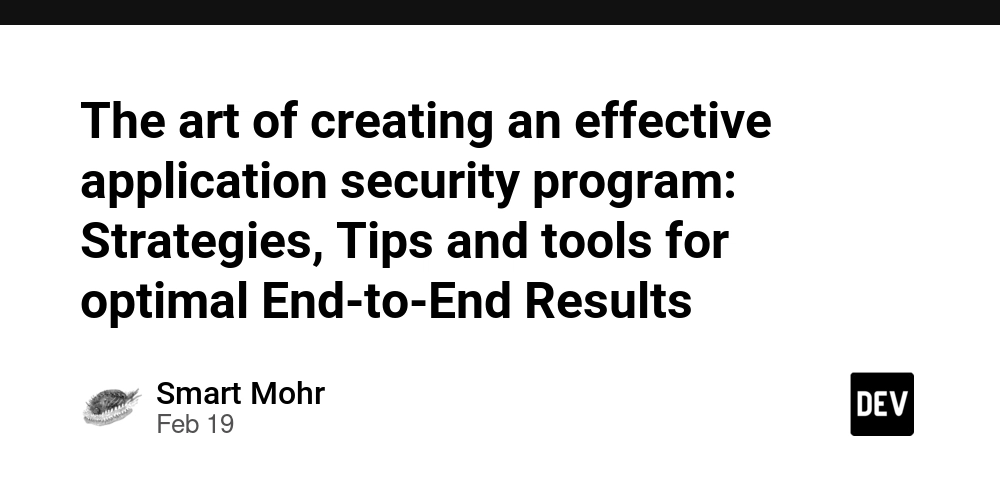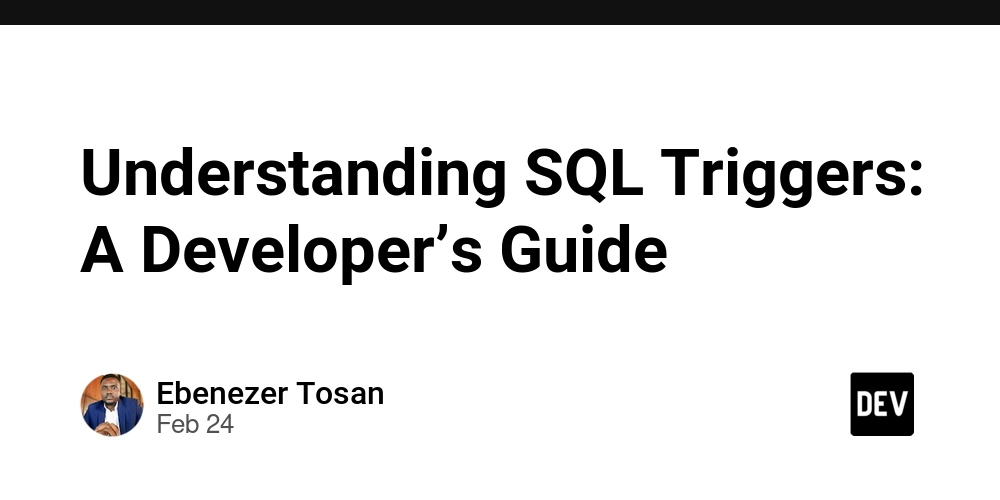The art of creating an effective application security program: Strategies, Tips and tools for optimal End-to-End Results
Navigating the complexities of contemporary software development necessitates a thorough, multi-faceted approach to application security (AppSec) that goes far beyond just vulnerability scanning and remediation. The constantly changing threat landscape, coupled with the rapid pace of technological advancement and the growing intricacy of software architectures, requires a comprehensive, proactive strategy that seamlessly integrates security into each phase of the development process. This comprehensive guide explores the fundamental components, best practices and cutting-edge technologies that form the basis of an extremely effective AppSec program, which allows companies to fortify their software assets, reduce threats, and promote an environment of security-first development. The underlying principle of the success of an AppSec program is a fundamental shift in thinking that views security as a crucial part of the process of development, rather than an afterthought or separate undertaking. This paradigm shift requires close cooperation between developers, security personnel, operations, and other personnel. It helps break down the silos and creates a sense of shared responsibility, and promotes an approach that is collaborative to the security of software that they develop, deploy or manage. When adopting the DevSecOps method, organizations can integrate security into the fabric of their development workflows and ensure that security concerns are considered from the initial phases of design and ideation through to deployment as well as ongoing maintenance. One of the most important aspects of this collaborative approach is the formulation of clear security guidelines standards, guidelines, and standards which provide a structure for safe coding practices, risk modeling, and vulnerability management. These guidelines should be based on the best practices of industry, including the OWASP top ten, NIST guidelines and the CWE. They should also take into consideration the distinct requirements and risk that an application's and the business context. These policies can be codified and made accessible to everyone to ensure that companies use a common, uniform security strategy across their entire portfolio of applications. It is essential to invest in security education and training programs to aid in the implementation of these guidelines. These initiatives should seek to provide developers with knowledge and skills necessary to write secure code, identify potential vulnerabilities, and adopt best practices in security throughout the development process. application testing ai Training should cover a wide spectrum of topics such as secure coding techniques and common attack vectors to threat modeling and design for secure architecture principles. Through fostering a culture of constant learning and equipping developers with the tools and resources needed to build security into their daily work, companies can establish a strong base for an effective AppSec program. Security testing is a must for organizations. and verification methods in addition to training to spot and fix vulnerabilities prior to exploiting them. This requires a multi-layered approach which includes both static and dynamic analysis techniques and manual penetration tests and code reviews. In the early stages of development Static Application Security Testing tools (SAST) can be used to identify vulnerabilities such as SQL Injection, Cross-Site Scripting (XSS) and buffer overflows. Dynamic Application Security Testing tools (DAST), on the other hand can be used to simulate attacks against running applications to detect vulnerabilities that could not be detected by static analysis. Although these automated tools are crucial to identify potential vulnerabilities at large scale, they're not a panacea. Manual penetration tests and code reviews performed by highly skilled security experts are crucial for uncovering more complex, business logic-related vulnerabilities that automated tools could miss. Combining automated testing with manual validation enables organizations to gain a comprehensive view of their security posture. They can also prioritize remediation strategies based on the degree and impact of the vulnerabilities. Enterprises must make use of modern technology, like artificial intelligence and machine learning to enhance their capabilities in security testing and vulnerability assessments. AI-powered tools are able to analyze huge quantities of application and code data, identifying patterns and anomalies that could be a sign of security issues. They can also enhance their ability to detect and prevent new threats through learning from vulnerabilities that have been exploited and previous attacks patterns. Code property graphs are an exciting AI application in AppSec. They can be used to detect and repair vulnerabilities more precisely and effectively. CPGs are a detailed representation of an application’s codebase that no

Navigating the complexities of contemporary software development necessitates a thorough, multi-faceted approach to application security (AppSec) that goes far beyond just vulnerability scanning and remediation. The constantly changing threat landscape, coupled with the rapid pace of technological advancement and the growing intricacy of software architectures, requires a comprehensive, proactive strategy that seamlessly integrates security into each phase of the development process. This comprehensive guide explores the fundamental components, best practices and cutting-edge technologies that form the basis of an extremely effective AppSec program, which allows companies to fortify their software assets, reduce threats, and promote an environment of security-first development.
The underlying principle of the success of an AppSec program is a fundamental shift in thinking that views security as a crucial part of the process of development, rather than an afterthought or separate undertaking. This paradigm shift requires close cooperation between developers, security personnel, operations, and other personnel. It helps break down the silos and creates a sense of shared responsibility, and promotes an approach that is collaborative to the security of software that they develop, deploy or manage. When adopting the DevSecOps method, organizations can integrate security into the fabric of their development workflows and ensure that security concerns are considered from the initial phases of design and ideation through to deployment as well as ongoing maintenance.
One of the most important aspects of this collaborative approach is the formulation of clear security guidelines standards, guidelines, and standards which provide a structure for safe coding practices, risk modeling, and vulnerability management. These guidelines should be based on the best practices of industry, including the OWASP top ten, NIST guidelines and the CWE. They should also take into consideration the distinct requirements and risk that an application's and the business context. These policies can be codified and made accessible to everyone to ensure that companies use a common, uniform security strategy across their entire portfolio of applications.
It is essential to invest in security education and training programs to aid in the implementation of these guidelines. These initiatives should seek to provide developers with knowledge and skills necessary to write secure code, identify potential vulnerabilities, and adopt best practices in security throughout the development process. application testing ai Training should cover a wide spectrum of topics such as secure coding techniques and common attack vectors to threat modeling and design for secure architecture principles. Through fostering a culture of constant learning and equipping developers with the tools and resources needed to build security into their daily work, companies can establish a strong base for an effective AppSec program.
Security testing is a must for organizations. and verification methods in addition to training to spot and fix vulnerabilities prior to exploiting them. This requires a multi-layered approach which includes both static and dynamic analysis techniques and manual penetration tests and code reviews. In the early stages of development Static Application Security Testing tools (SAST) can be used to identify vulnerabilities such as SQL Injection, Cross-Site Scripting (XSS) and buffer overflows. Dynamic Application Security Testing tools (DAST), on the other hand can be used to simulate attacks against running applications to detect vulnerabilities that could not be detected by static analysis.
Although these automated tools are crucial to identify potential vulnerabilities at large scale, they're not a panacea. Manual penetration tests and code reviews performed by highly skilled security experts are crucial for uncovering more complex, business logic-related vulnerabilities that automated tools could miss. Combining automated testing with manual validation enables organizations to gain a comprehensive view of their security posture. They can also prioritize remediation strategies based on the degree and impact of the vulnerabilities.
Enterprises must make use of modern technology, like artificial intelligence and machine learning to enhance their capabilities in security testing and vulnerability assessments. AI-powered tools are able to analyze huge quantities of application and code data, identifying patterns and anomalies that could be a sign of security issues. They can also enhance their ability to detect and prevent new threats through learning from vulnerabilities that have been exploited and previous attacks patterns.
Code property graphs are an exciting AI application in AppSec. They can be used to detect and repair vulnerabilities more precisely and effectively. CPGs are a detailed representation of an application’s codebase that not only shows its syntactic structure, but additionally complex dependencies and connections between components. Utilizing the power of CPGs, AI-driven tools can do a deep, context-aware assessment of an application's security profile in identifying security vulnerabilities that could be overlooked by static analysis techniques.
CPGs are able to automate the process of remediating vulnerabilities by applying AI-powered techniques to repair and transformation of the code. AI powered application security By understanding the semantic structure of the code, as well as the nature of the identified vulnerabilities, AI algorithms can generate targeted, specific fixes to target the root of the problem instead of merely treating the symptoms. This approach does not just speed up the remediation but also reduces any possibility of breaking functionality, or introducing new weaknesses.
Integration of security testing and validation in the continuous integration/continuous deployment (CI/CD) pipeline is a key component of an effective AppSec. Through automating security checks and embedding them in the process of building and deployment, companies can spot vulnerabilities early and avoid them getting into production environments. The shift-left security method allows for more efficient feedback loops and decreases the time and effort needed to discover and fix vulnerabilities.
In order to achieve the level of integration required, companies must invest in the appropriate infrastructure and tools to support their AppSec program. Not only should the tools be utilized for security testing however, the platforms and frameworks which allow integration and automation. Containerization technologies such Docker and Kubernetes could play a significant part in this, creating a reliable, consistent environment for running security tests as well as separating potentially vulnerable components.
Effective collaboration and communication tools are just as important as a technical tool for establishing a culture of safety and making it easier for teams to work in tandem. Issue tracking systems such as Jira or GitLab, can help teams identify and address vulnerabilities, while chat and messaging tools like Slack or Microsoft Teams can facilitate real-time exchange of information and communication between security specialists as well as development teams.
Ultimately, the success of the success of an AppSec program is not just on the tools and techniques employed, but also the process and people that are behind the program. To build a culture of security, you must have leadership commitment with clear communication and an effort to continuously improve. Organisations can help create an environment that makes security more than a tool to mark, but an integral aspect of growth through fostering a shared sense of accountability as well as encouraging collaboration and dialogue offering resources and support and encouraging a sense that security is an obligation shared by all.
For their AppSec programs to be effective over time organisations must develop important metrics and key-performance indicators (KPIs). These KPIs will help them track their progress and pinpoint improvement areas. These metrics should encompass the entire lifecycle of applications, from the number of vulnerabilities discovered during the development phase, to the time required to fix issues and the security status of applications in production. By constantly monitoring and reporting on these indicators, companies can demonstrate the value of their AppSec investment, discover patterns and trends and make informed decisions regarding the best areas to focus their efforts.
Moreover, organizations must engage in continuous learning and training to stay on top of the ever-changing threat landscape and emerging best methods. This could include attending industry conferences, participating in online training courses as well as collaborating with outside security experts and researchers to stay on top of the most recent trends and techniques. In fostering a culture that encourages continuing learning, organizations will assure that their AppSec program is adaptable and robust in the face of new threats and challenges.
It is crucial to understand that application security is a continuous procedure that requires continuous investment and commitment. As new technologies develop and development methods evolve organisations must continuously review and modify their AppSec strategies to ensure that they remain efficient and in line with their business goals. https://www.youtube.com/watch?v=vZ5sLwtJmcU By adopting a continuous improvement mindset, promoting collaboration and communication, and leveraging advanced technologies such CPGs and AI, organizations can create an efficient and flexible AppSec program that does not just protect their software assets, but also help them innovate in a rapidly changing digital world.
application testing ai











































































































































































![[The AI Show Episode 142]: ChatGPT’s New Image Generator, Studio Ghibli Craze and Backlash, Gemini 2.5, OpenAI Academy, 4o Updates, Vibe Marketing & xAI Acquires X](https://www.marketingaiinstitute.com/hubfs/ep%20142%20cover.png)




























































































































![[DEALS] The Premium Learn to Code Certification Bundle (97% off) & Other Deals Up To 98% Off – Offers End Soon!](https://www.javacodegeeks.com/wp-content/uploads/2012/12/jcg-logo.jpg)


![From drop-out to software architect with Jason Lengstorf [Podcast #167]](https://cdn.hashnode.com/res/hashnode/image/upload/v1743796461357/f3d19cd7-e6f5-4d7c-8bfc-eb974bc8da68.png?#)








































































































.png?#)

































_Christophe_Coat_Alamy.jpg?#)
 (1).webp?#)





































































































![Apple Considers Delaying Smart Home Hub Until 2026 [Gurman]](https://www.iclarified.com/images/news/96946/96946/96946-640.jpg)
![iPhone 17 Pro Won't Feature Two-Toned Back [Gurman]](https://www.iclarified.com/images/news/96944/96944/96944-640.jpg)
![Tariffs Threaten Apple's $999 iPhone Price Point in the U.S. [Gurman]](https://www.iclarified.com/images/news/96943/96943/96943-640.jpg)




































































































































